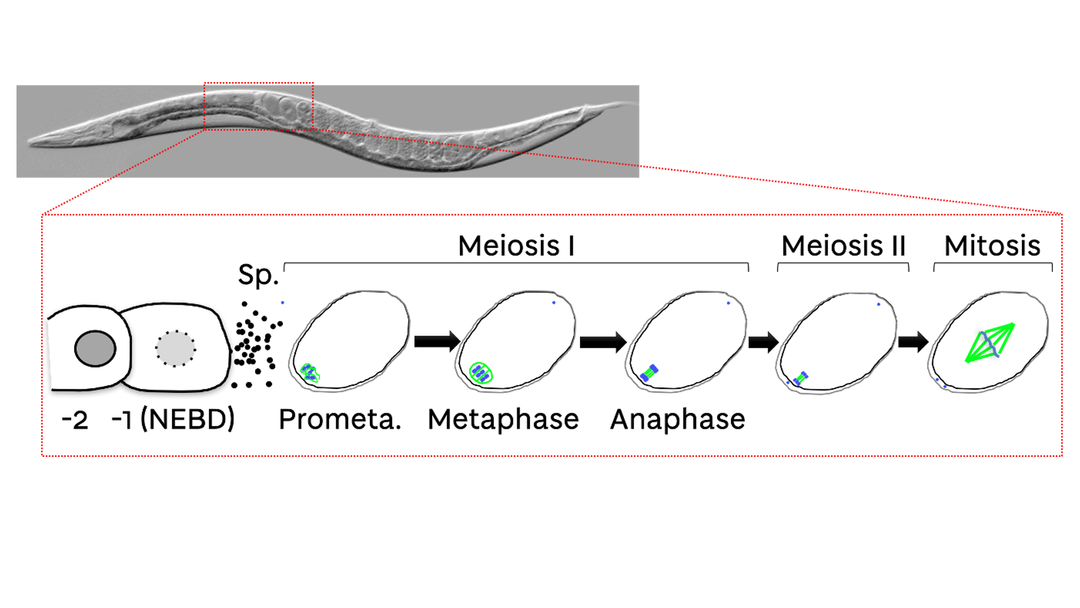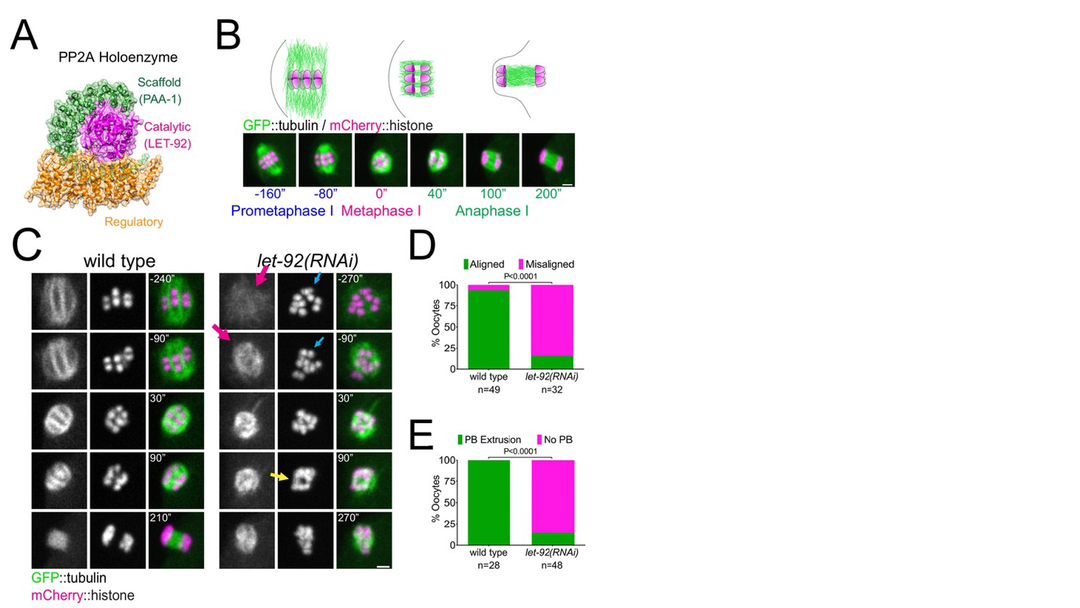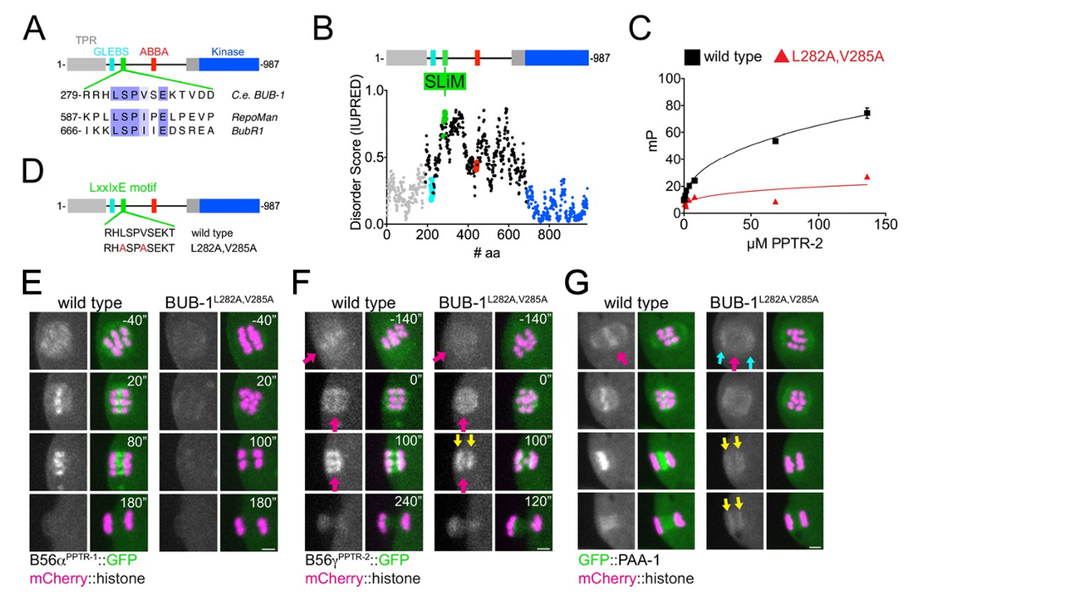Dr Fede Pelisch
Principal Investigator
Molecular Cell and Developmental Biology, School of Life Sciences

Contact
Research
My lab started in 2018 funded by a Career Development Fellowship from the Medical Research Council. My group is interested in understanding the mechanisms regulating chromosome segregation during meiosis and mitosis. We use the nematode Caenorhabditis elegans as a model system (Figure 1) and we employ a variety of methodologies including biochemical analysis, high-resolution imaging, and a range of genetics tools. During the last five years we focused on understanding the role of dynamic phosphorylation and dephosphorylation during chromosome segregation in oocyte meiosis.

Figure 1: C. elegans oocytes and embryos. A representative image of a C. elegans worm is shown. The schematic below highlights the region of the worm where the meiotic and first mitotic divisions occur.
By combining high-resolution microscopy with biochemical methods, we described different roles for the phosphatase PP2A/B56 during oocyte meiosis and identified the mechanism of PP2A/B56 targeting to chromosomes in specific meiotic stages (Figures 2&3; Bel Borja et al. 2020).

Figure 2: Protein Phosphatase 2A (PP2A) is essential for meiosis I in C. elegans oocytes.
(A) Schematic of the PP2A heterotrimer highlighting the single catalytic and scaffold subunits in C. elegans (LET-92 and PAA-1, respectively). The schematic was generated from the PDB structure 2npp. (B) Schematic of the different meiosis I stages in the C. elegans oocytes. The spindle moves towards the cortex, it rotates and shortens and chromosomes segregate to opposite spindle poles. (C) Microtubule and chromosome dynamics were followed in wild type and let-92(RNAi) oocytes expressing GFP::tubulin and mCherry::histone. Magenta arrows point to defective spindle structure; the cyan arrow points to misaligned chromosomes; the yellow arrow shows an apparent separation between chromosome masses. Inset numbers represent the time relative to metaphase I in seconds. Scale bar, 2 µm. Note that in the absence of LET-92, a bipolar spindle does not form, chromosomes then do not segregate properly and meiosis is failed. (D) The number of oocytes with misaligned chromosomes in metaphase I was compared between wild-type and let-92(RNAi) oocytes and the percentage is represented (p<0.0001, Fisher’s exact test). ~80% of LET-92-depleted oocytes have misaligned chromosomes. (E) The number of oocytes with an extruded polar body (PB) after meiosis I in wild-type and let-92(RNAi) oocytes was analysed and the percentage is represented (p<0.0001, Fisher’s exact test). ~80% of LET-92-depleted oocytes do not extrude a polar body.

Figure 3: B56αPPTR-1 and B56γPPTR-2 are targeted through a LxxIxE motif in BUB-1.
(A) C. elegans BUB-1 B56 binding motif is shown aligned with those of BubR1 and Repoman. (B) Disorder prediction of full-length BUB-1. (C) PPTR-2 interaction with an LxxIxE motif-containing synthetic peptide was assessed using fluorescence polarisation. (D) Schematic showing the LxxIxE motif in BUB-1 and the BUB-1L282A,V285A mutant. (E) B56αPPTR-1 and chromosome dynamics were followed in wild-type and in BUB-1L282A,V285A oocytes expressing PPTR-1::GFP and mCherry::histone. (F) B56γPPTR-2 and chromosome dynamics were followed in wild-type and in BUB-1L282A,V285Aoocytes expressing PPTR-2::GFP and mCherry::histone. (G) GFP::PAA-1 is present on chromosomes in the BUB-1L282A,V285A mutant. PAA-1 and chromosome dynamics were followed in wild-type and BUB-1L282A,V285A oocytes expressing GFP::PAA-1 and mCherry::histone.
More recently, we used chemical genetics to describe the different roles of PLK1 during oocyte meiosis while at the same time characterised its targeting mechanism to meiotic chromosomes (Figures 4-6; Taylor et al. 2023). We are currently following up on these findings focusing on the identification of key substrates for both PLK-1 and PP2A/B56 and we are also trying to understand their interplay during mitosis.
We are currently focusing on understanding the different roles of two separate populations of PLK-1 within the kinetochore. Our long-term vision is to understand the dynamic interplay of different post-translational modifications (such us sumoylation and phosphorylation) during chromosome segregation.
Selected Publications
Taylor, S.J.P.; Bel Borja, L.; Soubigou, F.; Houston, J.; Cheerambathur, D.K.; and Pelisch, F*. BUB-1 and CENP-C recruit PLK-1 to Control Chromosome Alignment and Segregation During Meiosis I in C. elegans Oocytes. eLife 12:e84057 (2023) doi: 10.7554/eLife.84057
Bel Borja, L.; Soubigou, F.; Taylor, S.J.P.; Fraguas Bringas, C.; Budrewicz, J.; Lara-Gonzalez, P.; Sorensen Turpin, C.G.; Bembenek, J.N.; Cheerambathur, D.K.; and Pelisch, F*. BUB-1 targets PP2A:B56 to regulate chromosome congression during meiosis I in C. elegans oocytes. eLife 9:e65307 (2020) doi: 10.7554/eLife.65307.
Taylor, S.J.P and Pelisch, F*. Chromosome segregation during female meiosis in C. elegans: a tale of pushing and pulling. Journal of Cell Biology (2020); doi: 10.1083/jcb.202011035.
Pelisch, F.* et al. Sumoylation regulates protein dynamics during meiotic chromosome segregation in oocytes. Journal of Cell Science, 2019. 132(14): p.jcs232330. doi: 10.1242/jcs.232330
Pelisch, F. et al. A SUMO-dependent protein network regulates chromosome congression during oocyte meiosis. Molecular Cell (2017), 65:66-77. doi: 10.1016/j.molcel.2016.11.001
Pelisch, F.* & Hay, R.T. Tools to study SUMO conjugation in C. elegans.Methods Mol Biol. 2016;1475:233-56. doi: 10.1007/978-1-4939-6358-4_17.
Pelisch, F. et al. Dynamic SUMO modification regulates mitotic chromosome assembly and cell cycle progression in Caenorhabditis elegans. Nature Communications (2014) Dec 5;5:5485. doi: 10.1038/ncomms6485.
People in my Lab
- Dr. Laura Bel Borja
- Flavie Soubigou
- Sam Taylor
Awards
| Award | Year |
|---|---|
| Personal Fellowships / MRC Career Development Fellowship | 2017 |
| Molecular and Cellular Biology Prize | 2016 |
Stories

News
Federico (Fede) Pelisch has been appointed to the eLife Board of Directors.